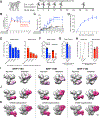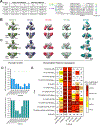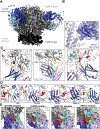Vaccine induction of CD4-mimicking HIV-1 broadly neutralizing antibody precursors in macaques
- PMID: 38181743
- PMCID: PMC10860651
- DOI: 10.1016/j.cell.2023.12.002
Vaccine induction of CD4-mimicking HIV-1 broadly neutralizing antibody precursors in macaques
Abstract
The CD4-binding site (CD4bs) is a conserved epitope on HIV-1 envelope (Env) that can be targeted by protective broadly neutralizing antibodies (bnAbs). HIV-1 vaccines have not elicited CD4bs bnAbs for many reasons, including the occlusion of CD4bs by glycans, expansion of appropriate naive B cells with immunogens, and selection of functional antibody mutations. Here, we demonstrate that immunization of macaques with a CD4bs-targeting immunogen elicits neutralizing bnAb precursors with structural and genetic features of CD4-mimicking bnAbs. Structures of the CD4bs nAb bound to HIV-1 Env demonstrated binding angles and heavy-chain interactions characteristic of all known human CD4-mimicking bnAbs. Macaque nAb were derived from variable and joining gene segments orthologous to the genes of human VH1-46-class bnAb. This vaccine study initiated in primates the B cells from which CD4bs bnAbs can derive, accomplishing the key first step in the development of an effective HIV-1 vaccine.
Keywords: CD4 binding site; CD4-mimetic antibody; EM polyclonal epitope mapping; EMPEM; HIV vaccine; broadly neutralizing antibodies; cryo-EM; cryo-electron microscopy; rhesus macaques.
Copyright © 2023 Elsevier Inc. All rights reserved.
Conflict of interest statement
Declaration of interests Y.K.T. and C.B. are employees of Acuitas Therapeutics. D.W. and Y.K.T. are named on a patent describing the use of nucleoside-modified mRNA in lipid nanoparticles as a vaccine platform. D.W. is named on patents that describe the use of nucleoside-modified mRNA as a platform to deliver therapeutic proteins. K.O.S., D.C.M., R.H., P.A., and B.F.H. have patents concerning the envelope immunogens used in this study.
Figures






References
-
- Moldt B, Rakasz EG, Schultz N, Chan-Hui PY, Swiderek K, Weisgrau KL, Piaskowski SM, Bergman Z, Watkins DI, Poignard P, and Burton DR. (2012). Highly potent HIV-specific antibody neutralization in vitro translates into effective protection against mucosal SHIV challenge in vivo. Proc Natl Acad Sci U S A 109, 18921–18925. 10.1073/pnas.1214785109. - DOI - PMC - PubMed
-
- Mascola JR, Stiegler G, VanCott TC, Katinger H, Carpenter CB, Hanson CE, Beary H, Hayes D, Frankel SS, Birx DL, and Lewis MG. (2000). Protection of macaques against vaginal transmission of a pathogenic HIV-1/SIV chimeric virus by passive infusion of neutralizing antibodies. Nat Med 6, 207–210. 10.1038/72318. - DOI - PubMed
Publication types
MeSH terms
Substances
Grants and funding
LinkOut - more resources
Full Text Sources
Research Materials
Miscellaneous

